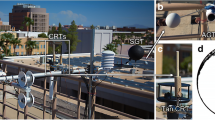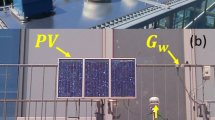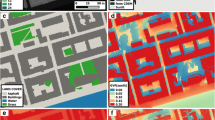Abstract
Given the predominant use of heat-retaining materials in urban areas, numerous studies have addressed the urban heat island mitigation potential of various “cool” options, such as vegetation and high-albedo surfaces. The influence of altered radiational properties of such surfaces affects not only the air temperature within a microclimate, but more importantly the interactions of long- and short-wave radiation fluxes with the human body. Minimal studies have assessed how cool surfaces affect thermal comfort via changes in absorbed radiation by a human (R abs) using real-world, rather than modeled, urban field data. The purpose of the current study is to assess the changes in the absorbed radiation by a human—a critical component of human energy budget models—based on surface type on hot summer days (air temperatures > 38.5∘C). Field tests were conducted using a high-end microclimate station under predominantly clear sky conditions over ten surfaces with higher sky view factors in Lubbock, Texas. Three methods were used to measure and estimate R abs: a cylindrical radiation thermometer (CRT), a net radiometer, and a theoretical estimation model. Results over dry surfaces suggest that the use of high-albedo surfaces to reduce overall urban heat gain may not improve acute human thermal comfort in clear conditions due to increased reflected radiation. Further, the use of low-cost instrumentation, such as the CRT, shows potential in quantifying radiative heat loads within urban areas at temporal scales of 5–10 min or greater, yet further research is needed. Fine-scale radiative information in urban areas can aid in the decision-making process for urban heat mitigation using non-vegetated urban surfaces, with surface type choice is dependent on the need for short-term thermal comfort, or reducing cumulative heat gain to the urban fabric.




Similar content being viewed by others
Change history
11 December 2017
The original article contains mistakes in Eqs. 12 and 13.
References
Ainsworth BE, Haskell WL, Whitt MC, Irwin ML, Swartz AM, Strath SJ, O’Brien WL (2000) Compendium of physical activities: an upyear of activity codes and MET intensities. Med Sci Sport Exer 32(9):498–516
Berko J, Ingram D, Saha A, Parker J (2014) Deaths attributed to heat, cold, and other weather events in the United States, 2006–2010. Tech. Rep. 76, National Center for Health Statistics
Bowler DE, Buyung-Ali L, Knight TM, Pullin AS (2010) Urban greening to cool towns and cities: a systematic review of the empirical evidence. Landsc Urban Plan 97(3):147–155
Brock F, Richardson S (2001) Meteorological measurement systems. Oxford University Press
Brown RD, Gillespie TJ (1986) Estimating outdoor thermal comfort using a cylindrical radiation thermometer and an energy budget model. Int J Biometeorol 30(1):43–52
Brown RD, Gillespie TJ (1995) Microclimate landscape design. John Wiley & Sons, Inc
Campbell G (1977) An introduction to environmental biophysics. Springer, New York
Campbell G, Norman J (1998) An introduction to environmental biophysics. Springer, New York Berlin Heidelberg
Chen L, Ng E, An X, Ren C, Lee M, Wang U, He Z (2012) Sky view factor analysis of street canyons and its implications for daytime intra-urban air temperature differentials in high-rise, high-density urban areas of Hong Kong: a GIS-based simulation approach. Int J Climatol 32(1):121–136
Chow WTL, Brennan D, Brazel AJ (2012) Urban heat island research in Phoenix, Arizona: theoretical contributions and policy applications. Bull Am Meteorol Soc 93(4):517–530
Deren TM, Coris EE, Casa DJ, DeMartini JK, Bain AR, Walz SM, Jay O (2014) Maximum heat loss potential is lower in football linemen during an NCAA summer training camp because of lower self-generated air flow. J Strength Cond Res 28(6):1656–1663
Erell E, Pearlmutter D, Boneh D, Kutiel PB (2014) Effect of high-albedo materials on pedestrian heat stress in urban street canyons. Urban Climate 10:367–386
Fanger PO (1970) Thermal comfort. Analysis and application in environmental engineering. Danish Technical Press, Copenhagen
Golden JS (2004) The built environment induced urban heat island effect in rapidly urbanizing arid regions—a sustainable urban engineering complexity. Environ Sci 1(2013):321–349
Grimm NB, Faeth SH, Golubiewski NE, Redman CL, Wu J, Bai X, Briggs JM (2008) Global change and the ecology of cities. Science 319(5864):756–760
Grimmond CSB, Roth M, Oke TR, Au YC, Best M, Betts R, Carmichael G, Cleugh H, Dabberdt W, Emmanuel R, Freitas E, Fortuniak K, Hanna S, Klein P, Kalkstein LS, Liu CH, Nickson A, Pearlmutter D, Sailor D, Voogt J (2010) Climate and more sustainable cities: climate information for improved planning and management of cities (Producers/Capabilities Perspective). Procedia Environ Sci 1:247–274
Grundstein A, Knox JA, Vanos J, Cooper ER, Casa DJ (2017) American football and fatal exertional heat stroke: a case study of Korey Stringer. Int J Biometeorol 1–10
Harlan SL, Brazel AJ, Prashad L, Stefanov WL, Larsen L (2006) Neighborhood microclimates and vulnerability to heat stress. Soc Sci Med 63:2847–2863
Holmer B, Lindberg F, Rayner D, Thorsson S (2015) How to transform the standing man from a box to a cylinder—a modified methodology to calculate mean radiant temperature in field studies and models ICUC9 - 9Th International Conference on Urban Climate, Toulouse, France
ISO9920 (2007) ISO 9920: Ergonomics of the thermal environment: estimation of thermal insulation and water vapour resistance of a clothing ensemble. ISO, Geneva
Jenerette G, Harlan S, Buyantuev A, Stefanov W, Declet-Barreto J, Ruddell B, Myint S, Kaplan S, Li X (2015) Micro scale urban surface temperatures are related to land cover features and residential heat-related health impacts in Phoenix, AZ USA. Landscape Ecology 10.1007/s10980-015-0284-3
Johansson E, Thorsson S, Emmanuel R, Krüger E (2014) Instruments and methods in outdoor thermal comfort studies—the need for standardization. Urban Climate 10:346–366
Kántor N, Lin TP, Matzarakis A (2014) Daytime relapse of the mean radiant temperature based on the six-directional method under unobstructed solar radiation. Int J Biometeorol 58:1615–1625
Kántor N, Unger J (2011) The most problematic variable in the course of human-biometeorological comfort assessment—the mean radiant temperature. Central European Journal of Geosciences 3(1):90–100
Kenny NA, Warland JS, Brown RD, Gillespie TG (2008) Estimating the radiation absorbed by a human. Int J Biometeorol 52(6):491–503
Kenny NA, Warland JS, Brown RD, Gillespie TG (2009a) Part A: Assessing the performance of the COMFA outdoor thermal comfort model on subjects performing physical activity. Int J Biometeorol 53:415–428
Kenny NA, Warland JS, Brown RD, Gillespie TG (2009b) Part B: revisions to the COMFA outdoor thermal comfort model for application to subjects performing physical activity. Int J Biometeorol 53:429–441
Ketterer C, Matzarakis A (2014) Human-biometeorological assessment of heat stress reduction by replanning measures in Stuttgart, Germany. Landsc Urban Plan 122:78–88
Knez I, Thorsson S (2006) Influences of culture and environmental attitude on thermal, emotional and perceptual evaluations of a public square. Int J Biometeorol 50(5):258–268
Kreith F, Black W (1980) Basic heat transfer. Harper and Row, New York
Krüger E, Drach P, Emmanuel R, Corbella O (2013) Urban heat island and differences in outdoor comfort levels in Glasgow, UK. Theor Appl Climatol 112(1-2):127–141
Krys Sa, Brown RD (1990) Radiation absorbed by a vertical cylinder in complex outdoor environments under clear sky conditions. Int J Biometeorol 34(2):69–75
Kuras E, Bernhard M, Calkins M, Ebi K, Hess J, Kintziger K, Jagger M, Middel A, Scott A, Spector J, Uejio C, Vanos J, Zaitchik B, Gohlke J, Hondula D (2017) Opportunities and challenges for personal heat exposure research. Environmental Health Perspectives
Kuras ER, Hondula DM, Brown-Saracino J (2015) Heterogeneity in individually experienced temperatures (IETs) within an urban neighborhood: insights from a new approach to measuring heat exposure. Int J Biometeorol 1–10
Lin T (2009) Thermal perception, adaptation and attendance in a public square in hot and humid regions. Build Environ 44(10):2017– 2026
Lindberg F, Onomura S, Grimmond C (2016) Influence of ground surface characteristics on the mean radiant temperature in urban areas. Int J Biometeorol 1–14
Matzarakis A, Muthers S, Koch E (2011) Human biometeorological evaluation of heat-related mortality in Vienna. Theor Appl Clim 105:1–10
Matzarakis A, Rutz F, Mayer H (2007) Modelling radiation fluxes in simple and complex environments, application of the RayMan model. Int J Biometeorol 51(4):323–334
McCullough EA, Kenney WL (2003) Thermal insulation and evaporative resistance of football uniforms. Med Sci Sports Exerc 35(5):832–837
Middel A, Häb K, Brazel AJ, Martin CA, Guhathakurta S (2014) Impact of urban form and design on mid-afternoon microclimate in phoenix local climate zones. Landsc Urban Plan 122:16–28
Middel A, Selover N, Hagen B, Chhetri N (2016) Impact of shade on outdoor thermal comfort—a seasonal field study in Tempe, Arizona. Int J Biochem 1–13
Monteith J (1973). In: Edward Arnold (ed) Principles of environmental physics, 1st edn. MA, Burlington
Monteith J, Unsworth M (1990) Principles of environmental physics, 2nd edn. Butterworth-Heinemann, Boston, MA
Monteith J, Unsworth M (2008) Principles of environmental physics, 3rd edn. Elsevier, Burlington, MA
Oke T (1987) Boundary layer climates, 2nd edn. Routledge , New York
Oke T, Zeuner G, Jauregui E (1992) The surface energy balance in Mexico City. Atmos Environ Part B 26(4):433–444
Rosenzweig C, Solecki W (2006) Mitigating New York City’s heat island with urban forestry. Living Roofs and Light Surfaces, New York, pp 1–5
Santamouris M (2014) Cooling the cities—a review of reflective and green roof mitigation technologies to fight heat island and improve comfort in urban environments. Sol Energy 103:682–703. doi:10.1016/j.solener.2012.07.003. http://www.sciencedirect.com/science/article/pii/S0038092X12002447
Sheridan SC (2002) The redevelopment of a weather-type classification scheme for North America. Int J Climatol 22(1):51–68
Snir K, Pearlmutter D, Erell E (2016) The moderating effect of water-efficient ground cover vegetation on pedestrian thermal stress. Landsc Urban Plan 152:1–12
Solís P, Vanos JK, Forbis RE (2016) The decision-making/accountability spatial incongruence problem for research linking environmental science and policy. Geographical Review
Steeneveld G, Koopmans S, Heusinkveld B, Van Hove L, Holtslag A (2011) Quantifying urban heat island effects and human comfort for cities of variable size and urban morphology in the Netherlands. J Geophys Res Atmos 116(D20)
Taleghani M, Sailor D, Ban-Weiss GA (2016) Micrometeorological simulations to predict the impacts of heat mitigation strategies on pedestrian thermal comfort in a los angeles neighborhood. Environ Res Lett 11(2)
Tan J, Zheng Y, Tang X, Guo C, Li L, Song G, Zhen X, Yuan D, Kalkstein AJ, Li F (2010) The urban heat island and its impact on heat waves and human health in Shanghai. Int J Biometeorol 54 (1):75–84
Theeuwes NE, Steeneveld GJ, Ronda RJ, Rotach MW, Holtslag AA (2015) Cool city mornings by urban heat. Environ Res Lett 10(11):114,022
Thorsson S, Lindberg F, Eliasson I, Holmer B (2007) Different methods for estimating the mean radiant temperature in an outdoor urban setting. Int J Climatol 27(14):1983–1993
Thorsson S, Lindqvist M, Lindqvist S (2004) Thermal bioclimatic conditions and patterns of behaviour in an urban park in Goteborg, Sweden. Int J Biometeorol 48:149–156
van den Brink A, Bruns D, Tobi H, Bell S (2016) Research in landscape architecture: methods and methodology. Taylor & Francis, https://books.google.com/books?id=cTR6DQAAQBAJ
Vanos J, Warland J, Gillespie T, Kenny N (2012a) Thermal comfort modelling of body temperature and psychological variations of a human exercising in an outdoor environment. Int J Biometeorol 56(1):21–32
Vanos J, Warland J, Gillespie T, Kenny N (2012) Thermal comfort modelling of body temperature and psychological variations of a human exercising in an outdoor environment. Int J Biometeorol 56(1):21–32
Vanos JK (2015) Childrens health and vulnerability in outdoor microclimates: a comprehensive review. Environ Int 76:1–15
Vanos JK, Middel A, McKercher G, Kuras ER, Ruddell B (2016) Hot playgrounds and childrens health: a multiscale analysis of surface temperatures in Arizona, USA. Landsc Urban Plan 146:29–42. doi:10.1016/j.landurbplan.2015.10.007
Vanos JK, Warland JS, Gillespie TJ, Kenny NA (2012) Improved predictive ability of climate-human-behaviour interactions with modifications to the COMFA outdoor energy budget model. Int J Biometeorol 56(6):1065–74
Vanos JK, Warland JS, Kenny NA (2010) Review of the physiology of human thermal comfort while exercising in urban landscapes and implications for bioclimatic design. Int J Biometeorol 54(4):319–334
Acknowledgements
The authors would like to thank the two anonymous reviewers for the very helpful guidance and suggestions to strengthen the manuscript. We would also like to thank Robert Brown and Terry Gillespie for the great discussion and insight they provided throughout the process, which helped lead to the success of this research project. Also thanks you to those who allowed us to set up the microclimate station on different surfaces throughout the city for our testing. Finally, to Tim Sliwinski for access to the MCOM roof station data, and Grant McKercher for the help with technical details in the manuscript.
Author information
Authors and Affiliations
Corresponding author
Additional information
A correction to this article is available online at https://doi.org/10.1007/s00484-017-1477-z.
Rights and permissions
About this article
Cite this article
Hardin, A.W., Vanos, J.K. The influence of surface type on the absorbed radiation by a human under hot, dry conditions. Int J Biometeorol 62, 43–56 (2018). https://doi.org/10.1007/s00484-017-1357-6
Received:
Revised:
Accepted:
Published:
Issue Date:
DOI: https://doi.org/10.1007/s00484-017-1357-6




